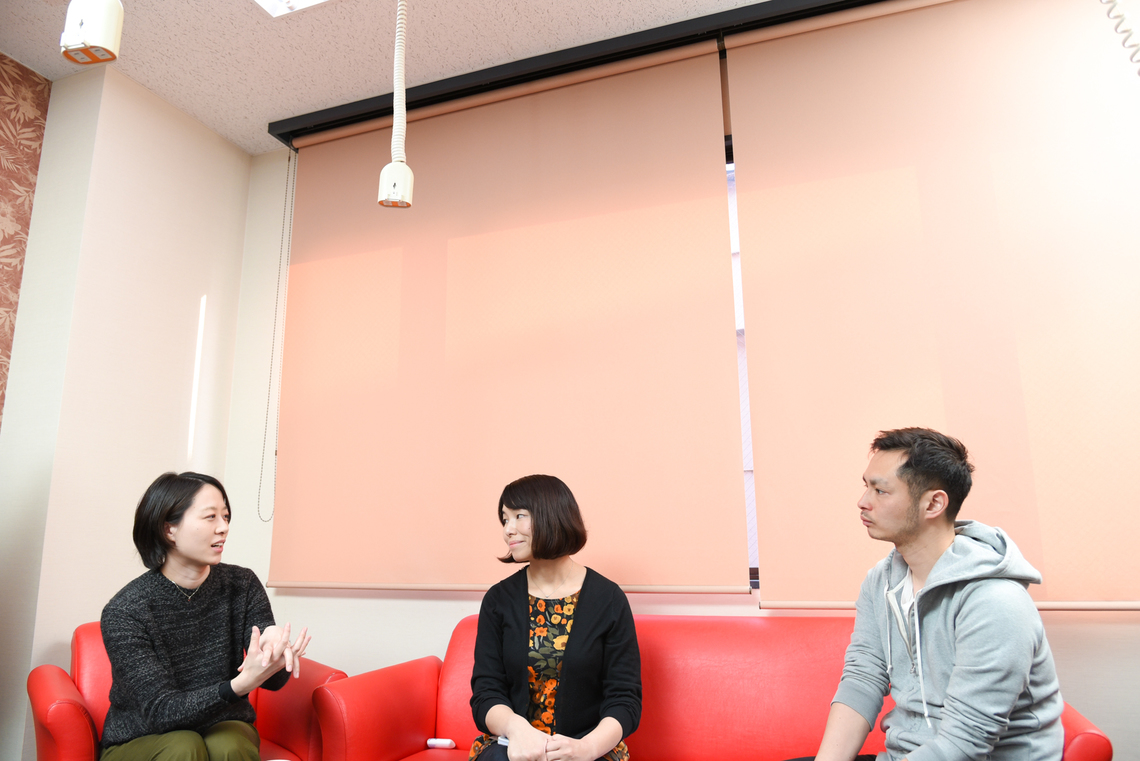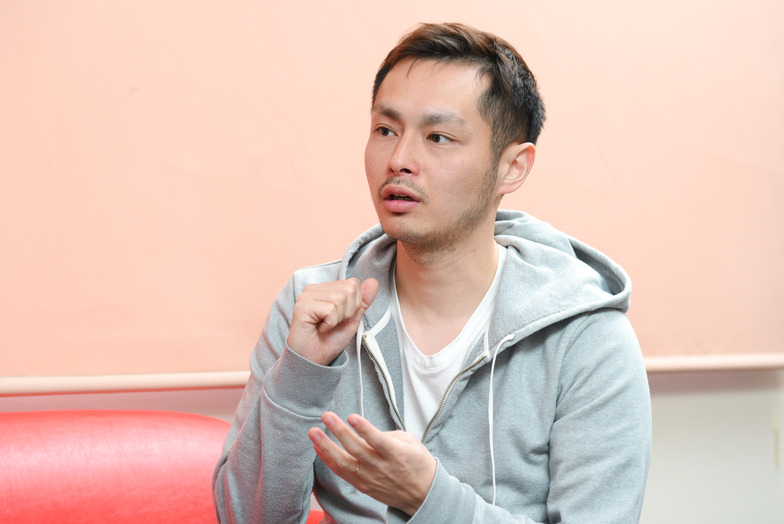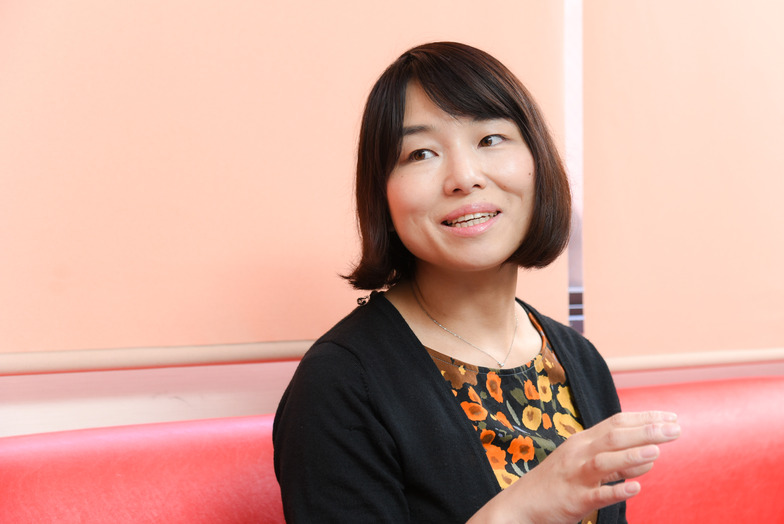Continuing from last time, we held a roundtable discussion with Kumi Imamura, Representative Director of the NPO Katariba, which provides career education to high school students; Yohei Kawabe, Representative Director of the NPO Ada Coda, which promotes "philosophical dialogue" in society and is developing methodologies for dialogue with 18-year-olds alongside Project18; and Rei Nagi, a Project18 member and staffer of Dentsu Inc. Youth Research Department (Dentsu Inc. Wakamon). Amidst the current spotlight on 18-year-olds, they discussed the potential and appeal of this age group.

(From left) Ms. Nagi, Ms. Imamura, Mr. Kawabe
Cultivating the "seeds" of ideas held by companies together with high school students
Nagi: With the lowering of the voting age, 18-year-olds are now attracting significant social attention. Is there anything new you'd like to challenge yourself with during this opportunity?
Imamura: I intend to focus more intently on my activities participating in education from a position outside the school system, which is my main profession. Beyond just the voting age change, 2020 will see simultaneous shifts surrounding 18-year-olds, including revisions to the National Curriculum Guidelines and university entrance exam reforms. Amidst these major transformations, our mission is to further strengthen the bridge between schools and society.
Nagi: Connecting with society is also a perspective we value at Dentsu Inc. Youth Research Department. I also think it's important to create structures for philosophy and dialogue within schools, as Mr. Kawabe mentioned. Are there any examples of philosophy dialogues being conducted in schools?
Kawabe: Some public high schools in Hawaii have formally incorporated philosophy dialogue as part of their curriculum. One school reportedly had severe bullying issues, but after introducing philosophy dialogue classes, the number of violent incidents decreased significantly.
Another aim is to strengthen critical thinking skills by discussing questions without clear answers. For example, in Singapore's top-tier schools, creative thinking that proposes solutions beyond just A versus B—like suggesting C or D—is valued. Philosophical dialogue is one approach used to foster this.
Imamura: In Japan too, there are good examples of creative thinking, varying by school and teacher. Right now, we're in the stage of intensely debating how to make learning in Japan more dialogic and collaborative, as a system where everyone can benefit from it.
This ties back to our previous discussion: creating a "safe zone" where students feel they can speak up about anything, as Mr. Kawabe mentioned, is crucial. To make schools such places, it's vital that teachers themselves secure a safe environment through the relationships within the staff room.
I believe that establishing a safe mood throughout the entire school is what creates the environment where true active learning can take root. With that foundation in place, I feel more and more schools will likely start incorporating the Ada Coda philosophy dialogue.
Kawabe: And ideally, even if not in the form of philosophy, some kind of dialogue should be established in all classes.
Nagi: That's right. As Project18, we also want to consider what support we can offer to increase dialogue within educational settings. Furthermore, since the 18-year-old market rarely receives this much attention, I hope we can provide some point of contact or insight for companies that previously thought, "We have nothing to do with young people or education."
Imamura: For instance, when high school students participate in product development, the needs of both the company and the students can align. However, the timing demanded by companies—like delivery schedules—often doesn't match educational timelines. When that happens, student involvement can become merely a token gesture, or schools might overextend themselves, disrupting regular educational activities. That makes it unsustainable.
We do receive inquiries from various companies, so I want to be able to coordinate a good match between corporate needs and educational needs.
Kawabe: When involving students in product development, it would be interesting to start discussions with high schoolers by asking, "Is this really necessary?" Rather than just listening to their opinions and saying "thank you," we should question whether it's fundamentally needed. What do people truly need? Maybe it's not a product at all, but an experience? If we pose that question, we might get unexpected answers. For the students, it's a valuable chance to learn planning methodologies from the ground up. Today's youth are great at taking a seed idea and growing it into something entirely different. Companies have plenty of these seeds that spark ideas – what if we planted them and let the students nurture them?
Nagi: Going forward, rather than just marketing products that appeal to 18-year-olds, there seems to be potential in engaging with them by providing topics for thought and spaces to explore their sensibilities and inner feelings.
"My Project": Shaping "What I Want It to Be" Yourself
Nagi: Katariba has a project where high school students explore what they wish things could be like, right?
Imamura: That's "My Project." How it started: After the Great East Japan Earthquake, we created collaborative schools in Onagawa Town and Otsuchi Town where children could study and share their stories. While working with these kids, we realized their worldview contained perspectives urban kids simply didn't know existed.
For example, I doubt kids in Tokyo ever think much about the elderly neighbors nearby. But kids in rural areas grow up with elders always present, even before the disaster. They live in a richness that can't be measured by numbers—places where bartering customs still exist.
Things noticed or wondered about in such environments might be things tens of thousands of people are wondering about. So, we decided to take action and give it form, and that's how this project began.
This year marks the third year since the project's launch. Every year, we hold the National My Project Awards, the Koshien of My Projects, and this year we received entries from 115 projects.
Nagi: I went to see the competition. It was fascinating to see that not all participants were the so-called "highly motivated" types; they were ordinary high school students pouring their wisdom into their projects.
Imamura: Yes, I think the strength of My Project lies in how it serves as a platform for such diverse students. Interestingly, it's often the academically gifted students, those with high test scores, who struggle more with setting their project themes. They're quick-thinking and skilled at gathering information, but they find it hard to articulate their own personal experiences. As a result, they tend to gravitate toward setting their themes around large-scale social issues.
Nagi: Based on my experience with Wakamon's activities, I also feel that while many students are very skilled at editing and curation—taking something from 1 to 100—there seems to be an increasing number who struggle to create something from 0 to 1. And I believe this is indeed becoming a reality.
Imamura: Of course, having a sense of concern about social issues isn't inherently bad. But My Project is about valuing your own thoughts and feelings, and undertaking action-oriented challenges. It's crucial to start your learning journey from what interests you personally and your own feelings. Every year, we see ideas adults would never think of, which is truly fascinating.
Nagi: I see. I'd like to hear more in detail about what kind of thoughts high school students have and what kind of My Projects they are tackling. And I'd be delighted if Mr. Kawabe could continue to assist us in exploring what kind of dialogue is effective for truly connecting with the students' perspectives. Thank you very much for today.








